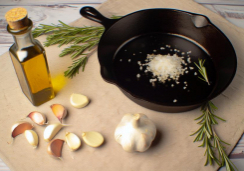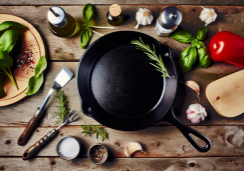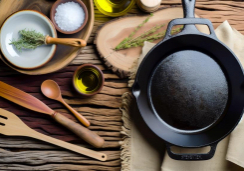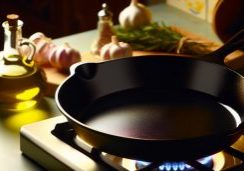Gluten-Free Baking: Tips and Delicious Recipes
Whisking, kneading, and baking—these are the familiar rhythms of creating delectable treats that fill your home with warmth and your palate with pleasure. But when you're navigating the world of gluten-free baking, you'll find that traditional methods don't always apply.
You've likely encountered the challenges of gritty textures, crumbly crusts, and disappointing flavors that can come with gluten-free recipes. Yet, with a few expert tips and carefully crafted recipes, you can master the art of gluten-free baking, turning out creations that are just as indulgent and satisfying as their wheat-based counterparts.
As you seek to transform your baking repertoire, remember that the key to success lies in understanding the unique properties of gluten-free flours and how to manipulate them to your advantage. Stay tuned for essential techniques that will help you achieve the perfect rise and structure, and discover a collection of recipes that promise to become beloved staples in your kitchen.
Essential Gluten-Free Ingredients
When embarking on gluten-free baking, it's crucial to stock your pantry with a variety of gluten-free flours and starches. These form the foundation of your recipes and require precise liquid adjustments to achieve the desired consistency.
You'll find that gluten-free baking requires a different approach—understanding how to measure flour correctly is key. A digital scale is your best bet for accuracy. This ensures that your all-purpose gluten-free flour and other GF flours like almond, coconut, or rice flours are used in just the right amounts.
Different gluten-free flours have unique properties. Some, like potato starch, add lightness to your baked goods, while others provide structure. Since gluten-free flours contain fine starches that absorb more liquid, you may find yourself adding more liquid to your mix to prevent a dry or crumbly outcome.
In addition, gluten-free baking tips often suggest using xanthan gum in gluten-free flour blends. This ingredient acts as a binder, mimicking gluten's elasticity and helping your doughs and batters hold together. Remember to increase leavening agents for that necessary rise, and don't shy away from adding an extra egg or two to improve the crumb and structure of your final bake.
With these nutritious tweaks, your gluten-free creations will be as delightful as their traditional counterparts.
Mastering Moisture Balance
Having established the foundation with the right gluten-free flours and binders, it's essential to focus on achieving the correct moisture balance for tender, delicious baked goods. When baking gluten-free, moisture balance is a pivotal factor that distinguishes a satisfyingly soft crumb from a dry, crumbly disappointment. Gluten-free flours often require additional moisture, as they don't retain water as well as wheat flour.
To enhance the moisture in your gluten-free baked goods, consider adding an extra egg, which can enrich the batter and improve texture. Alternatively, mix in sour cream or yogurt; these ingredients not only contribute moisture but also add a pleasant tanginess. For a naturally sweet moisture boost, pureed fruit like applesauce or mashed bananas can be a nutritious inclusion in your gluten-free recipe.
Sweeteners like brown sugar or honey are excellent for retaining moisture. Brown sugar contains molasses, which adds both flavor and a moist quality. Be cautious with these adjustments, though—additional liquid from honey or a higher proportion of brown sugar may require reducing other liquids in your gluten-free blend to maintain the desired consistency.
Recipe Adaptation Techniques
To successfully adapt traditional baking recipes to gluten-free versions, meticulously adjust baking times and temperatures, as gluten-free goods often need to bake longer at lower heat settings. When you're converting your favorite recipes to fit a gluten-free diet, you'll find that recipe adaptation techniques are invaluable.
For every cup of gluten-free flour used, consider adding moisture-enhancing ingredients such as pureed fruit or an extra egg, since gluten-free mixtures tend to be drier. Using a measuring cup that's meant for dry ingredients, measure your gluten-free flour carefully to avoid a dense texture.
Opt for an all-purpose blend that can substitute one-to-one for regular flour in most gluten-free baking recipes. To enhance flavors that might otherwise be subdued, don't hesitate to toss in a bit more vanilla or a pinch more spice. Be aware that gluten-free flour blends don't behave identically to wheat flour. They often require additional leavening agents, like baking powder or baking soda, to achieve the desired rise.
Adding a bit of dry milk per cup of gluten-free baking mix can also improve texture and taste. With a thoughtful approach to these recipe adaptation techniques, you'll master the art of gluten-free baking, creating delights that everyone can enjoy.
Baking Time Adjustments
While adapting your recipes to include gluten-free flour and additional moisture is crucial, it's equally important to adjust your baking times to ensure your creations turn out perfectly. In gluten-free baking, baked goods often require longer baking times at a lower oven temperature compared to their gluten-containing counterparts. This is because gluten-free flours, like those from Bob's Red Mill, behave differently than wheat flour.
When you convert your favorite recipes to gluten-free, start by using a cup-for-cup gluten-free flour blend. Then, be mindful that your baking time might change. Use an oven thermometer to verify your oven's temperature is accurate; even a slight variation could affect your baked goods. If you're using different types of pans, such as dark or non-stick, check the manufacturer's recommendations, as these can alter the baking time needed.
Place your treats in the center of a pre-heated oven to promote even baking. Remember, gluten-free recipes may need a gentle touch—keep an eye on your baked goods, and don't be afraid to tent them with foil if they're browning too quickly. Patience is key; allowing your gluten-free creations the time they need in the oven will reward you with delicious, perfectly textured treats.
Are the Tips and Recipes in the Gluten-Free Baking Guide Also Included in the Unlock Gluten-Free Baking Guide?
The comprehensive Unlock Gluten-Free Baking Guide is a treasure trove of glutenfree baking tips and recipes, ensuring every home baker can create mouth-watering delicacies without the worry of gluten. Whether you’re a novice or a seasoned baker, this guide is your partner for delicious, gluten-free success.
What are some essential tips and recipes for gluten-free baking?
For those embarking on a gluten-free baking journey, stocking up on glutenfree baking essentials discovery can make a world of difference. Items like almond flour, xanthan gum, and gluten-free baking powder are must-haves. And for delicious gluten-free treats, try recipes for chocolate chip cookies or banana bread using these essentials.
Gluten-Free Recipe Favorites
Dive into the world of gluten-free baking with recipes that not only cater to dietary restrictions but also burst with flavor and maintain a satisfying texture. Gluten-free recipe favorites range from hearty breads to delicate pastries, all crafted without the gluten to develop typical in traditional baking. If you're managing celiac disease or are sensitive to gluten, GF baking can be a delightful journey into alternative flours and innovative techniques.
When choosing a recipe, consider gluten-free flours like almond or coconut for high protein content, which can help replicate the structure usually provided by gluten. For an all-purpose solution, pre-made gluten-free all-purpose flour blends are convenient and versatile. Remember, gluten-free baked goods often need more moisture, so recipes that call for pureed fruit, sour cream, or yogurt are excellent for ensuring your treats don't turn out dry.
To combat the unfamiliar flavors some GF baking ingredients may have, don't hesitate to enhance your recipes with a variety of spices, extracts, or nuts. And to maintain the freshness of your gluten-free grains and starches, store them in the refrigerator or freezer. When you're ready to enjoy your gluten-free creations, any leftovers can be frozen to preserve their deliciousness for later.
Conclusion
You've now got the tools to conquer gluten-free baking! Remember, stock up on those key ingredients, balance moisture with precision, and tweak recipes until they're just right.
Adjusting baking times can make or break your creations, so keep an eye on the oven. Dive into those gluten-free favorites; your taste buds (and health!) will thank you.
Happy baking, and enjoy the delicious, nutritious benefits of your gluten-free masterpieces!










